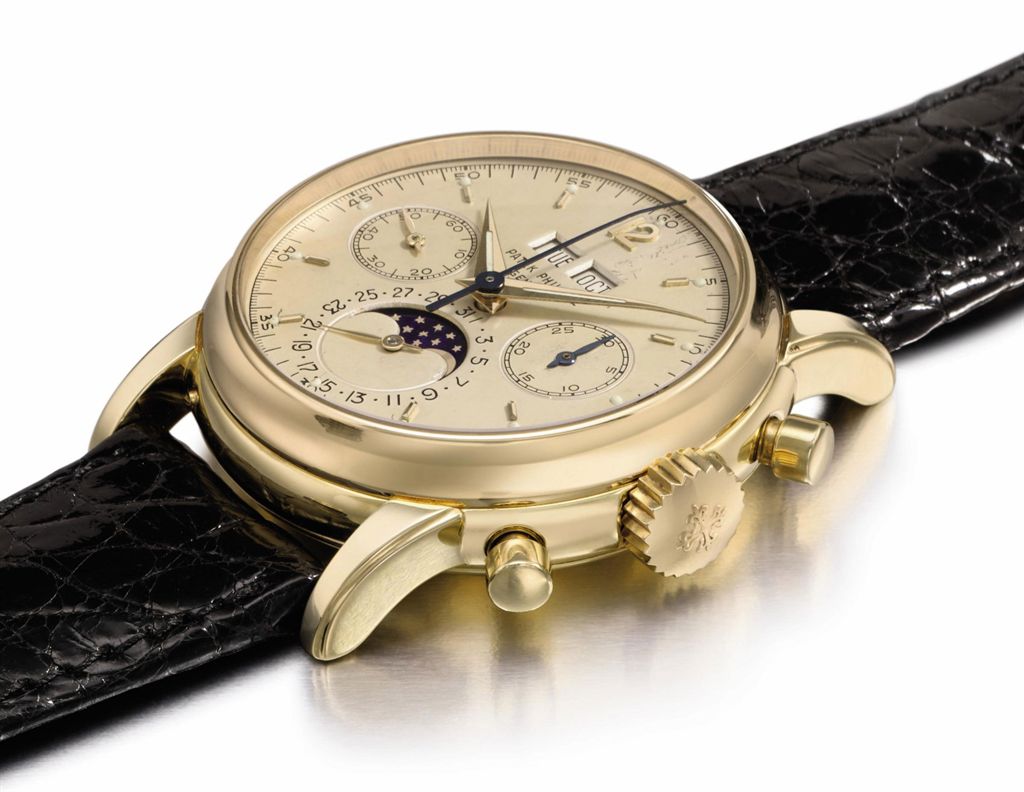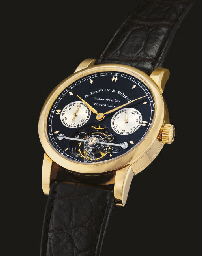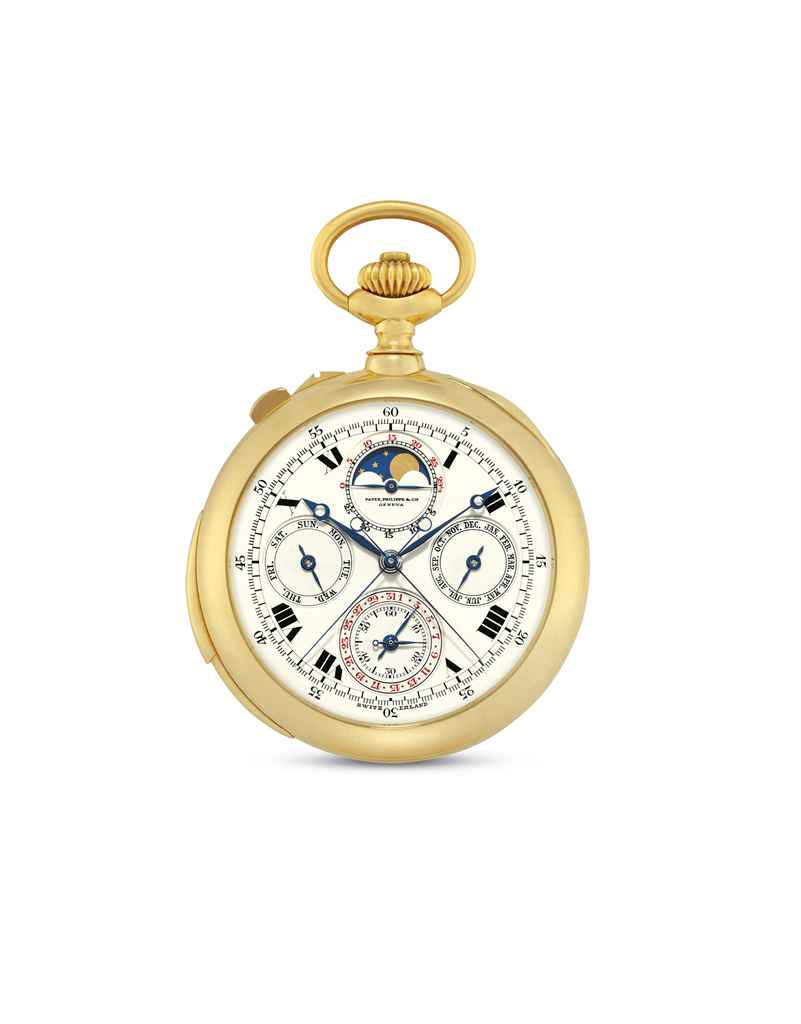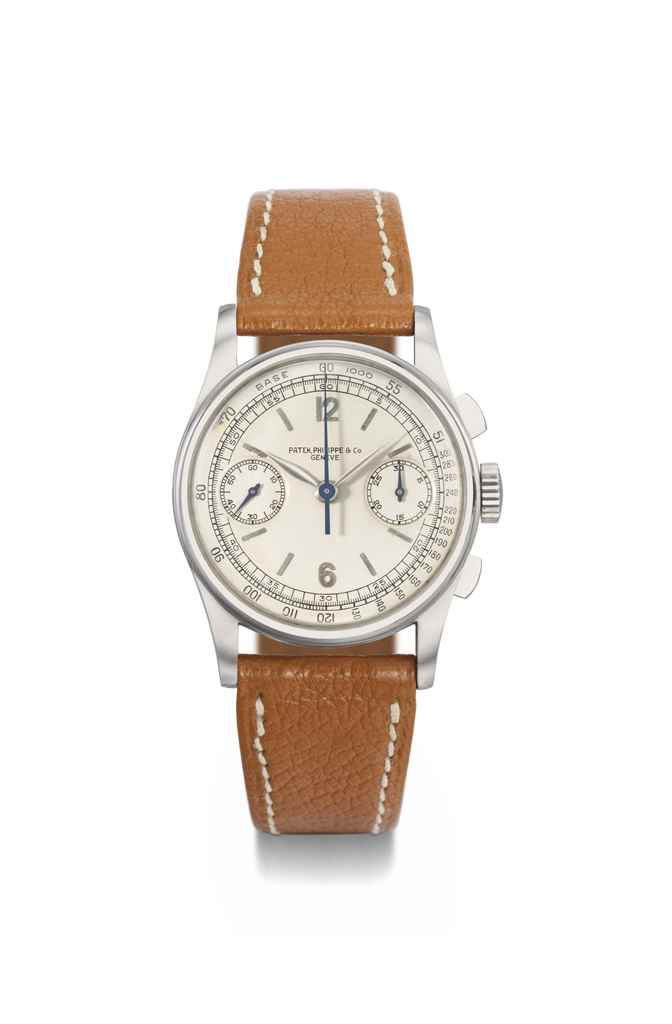A fine and rare Swiss gilt brass grande sonnerie striking circular travelling clock with push-button repeat and alarm Courvoisier and Company, La Chaux-de-Fonds, early 19th century The circular thirty-hour four pillar movement with chain fusee and verge escapement regulated by sprung three-arm monometallic balance to the going train, the hour and quarter striking trains driven by single spring barrel striking the full hour on a bell followed by ting-tang notation for the quarters on the same bell and a coiled gong every quarter hour, the alarm with standing barrel winding from the back and sounding on the bell, the backplate stamped 365 and fitted with six-spoke pierced balance bridge, regulation dial and full visible quarter and hour strikework, the 3 inch circular convex white enamel Arabic numeral dial with Arabic quarters to outer track and signed Courvoisier & Comp'e to centre, with steel moon hands and simple alarm setting pointer within generous engine-turned and repeating leaf cast bezel, the fine gilt engine-turned circular case with large diameter suspension ring and push-button above hinged ropetwist milled bezel (glass lacking), the rear with silk-backed pierced brass circular door, on four cast gilt brass ball-and-claw feet with three-position strike selection lever and repeat serial number 365 to underside between, diameter 12.5cm (5ins); 14.5cm (5.75ins) high with loop handle down. The firm of Courvoisier and Company was initially established as 'J. Robert et fils, Courvoisier et Cie' when Louis Courvoisier (who worked in La Chaux-de-Fonds from 1758) went into partnership with his father-in-law J. Robert in 1770. In 1787 Robert died leaving his widow to continue the partnership; with Louis Courvoisier later taking in his son, Frederic-Alexandre, to form 'Courvoisier et Cie' in 1811. The firm was continued after Louis Courvosier's death in 1832 by his sons later to became 'Courvoisier Freres' when Frederic-Alexandre left to set up business on his own in 1845. Several clocks signed 'Courvoisier & Comp'e' are known and it is generally thought that these were made during the period 1811-32. The style of the case of the current lot is interesting in that it is more akin to the Neo-Classical Beidermeier designs of the Austro-Hungarian Empire rather than the more traditional form of French/Swiss 'pendule d'officier'. The visible strikework to the rear of the backplate is typical of Swiss practice with similar work often seen on slightly earlier Neauchatel Bracket clocks. The current lot also appears to retain its original winding key which is stamped FC. IMPORTANT NOTES REGARDING THE CATALOGUING OF CLOCKS Movements, dials and cases: movements and dials are described as relating to the cases in which they are housed in one of the following three ways: the case.... we are of the opinion that the movement and dial started life in the current case. in a case... we are of the opinion that the movement and dial are in a case of correct period and type (and may well be original to the movement and dial), however there is evidence to suggest that they may not have started out life together. now in a case... we are of the opinion that the movement and dial are no longer in the original case or one of correct period and/or type. Pendulums, weights, winding and case keys: unless specifically indicated otherwise in the catalogue description it can be assumed that all clocks with cases are sold with the requisite pendulum and correct number of weights (where appropriate), however we cannot guarantee that they are original to the clock. We do not indicate in the catalogue description whether winding or case keys are present with any specific clock. As many clocks are consigned without keys please check with the department to establish whether they are present or not prior to bidding. Condition: due to the mechanical nature of clocks and the fact that most are of great age we cannot offer any guarantee as to whether they are in worki
A fine and rare Swiss gilt brass grande sonnerie striking circular travelling clock with push-button repeat and alarm Courvoisier and Company, La Chaux-de-Fonds, early 19th century The circular thirty-hour four pillar movement with chain fusee and verge escapement regulated by sprung three-arm monometallic balance to the going train, the hour and quarter striking trains driven by single spring barrel striking the full hour on a bell followed by ting-tang notation for the quarters on the same bell and a coiled gong every quarter hour, the alarm with standing barrel winding from the back and sounding on the bell, the backplate stamped 365 and fitted with six-spoke pierced balance bridge, regulation dial and full visible quarter and hour strikework, the 3 inch circular convex white enamel Arabic numeral dial with Arabic quarters to outer track and signed Courvoisier & Comp'e to centre, with steel moon hands and simple alarm setting pointer within generous engine-turned and repeating leaf cast bezel, the fine gilt engine-turned circular case with large diameter suspension ring and push-button above hinged ropetwist milled bezel (glass lacking), the rear with silk-backed pierced brass circular door, on four cast gilt brass ball-and-claw feet with three-position strike selection lever and repeat serial number 365 to underside between, diameter 12.5cm (5ins); 14.5cm (5.75ins) high with loop handle down. The firm of Courvoisier and Company was initially established as 'J. Robert et fils, Courvoisier et Cie' when Louis Courvoisier (who worked in La Chaux-de-Fonds from 1758) went into partnership with his father-in-law J. Robert in 1770. In 1787 Robert died leaving his widow to continue the partnership; with Louis Courvoisier later taking in his son, Frederic-Alexandre, to form 'Courvoisier et Cie' in 1811. The firm was continued after Louis Courvosier's death in 1832 by his sons later to became 'Courvoisier Freres' when Frederic-Alexandre left to set up business on his own in 1845. Several clocks signed 'Courvoisier & Comp'e' are known and it is generally thought that these were made during the period 1811-32. The style of the case of the current lot is interesting in that it is more akin to the Neo-Classical Beidermeier designs of the Austro-Hungarian Empire rather than the more traditional form of French/Swiss 'pendule d'officier'. The visible strikework to the rear of the backplate is typical of Swiss practice with similar work often seen on slightly earlier Neauchatel Bracket clocks. The current lot also appears to retain its original winding key which is stamped FC. IMPORTANT NOTES REGARDING THE CATALOGUING OF CLOCKS Movements, dials and cases: movements and dials are described as relating to the cases in which they are housed in one of the following three ways: the case.... we are of the opinion that the movement and dial started life in the current case. in a case... we are of the opinion that the movement and dial are in a case of correct period and type (and may well be original to the movement and dial), however there is evidence to suggest that they may not have started out life together. now in a case... we are of the opinion that the movement and dial are no longer in the original case or one of correct period and/or type. Pendulums, weights, winding and case keys: unless specifically indicated otherwise in the catalogue description it can be assumed that all clocks with cases are sold with the requisite pendulum and correct number of weights (where appropriate), however we cannot guarantee that they are original to the clock. We do not indicate in the catalogue description whether winding or case keys are present with any specific clock. As many clocks are consigned without keys please check with the department to establish whether they are present or not prior to bidding. Condition: due to the mechanical nature of clocks and the fact that most are of great age we cannot offer any guarantee as to whether they are in worki















Testen Sie LotSearch und seine Premium-Features 7 Tage - ohne Kosten!
Lassen Sie sich automatisch über neue Objekte in kommenden Auktionen benachrichtigen.
Suchauftrag anlegen